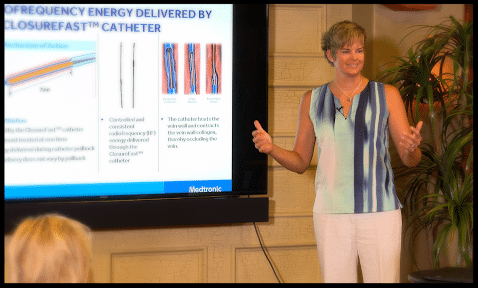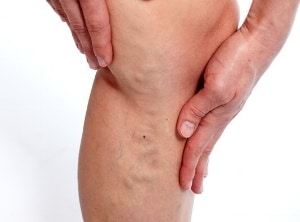
Restless Leg Syndrome and Varicose Veins
What is Restless Leg Syndrome
Restless leg syndrome (RLS), also called Willis-Ekbom disease (WED), is a common sleep-related movement disorder characterized by an unpleasant urge to move the legs. Symptoms often occur during periods of inactivity; particularly in the evenings. This urge to move is sometimes relieved by moving ones legs. During sleep, most patients’ limb movements, called periodic limb movements of sleep (PLMS), can wake the person from sleep. Common symptoms of restless leg include: need to move, a sensation of crawling, tingling, restless, leg cramping, leg pain, leg discomfort, and leg itching. (Similar terms have been used when patients describe symptoms associated with venous disease or varicose veins.)
Cause of Restless Leg Syndrome
The cause of restless legs syndrome remains poorly understood. Some studies have identified nervous system abnormalities in patients with the disorder. The most common conditions associated with RLS include: iron deficiency, renal failure, neuropathy, spinal cord issues, pregnancy, and multiple sclerosis. Antihistamines, antipsychotic medications, and many anti-nausea medications, and certain antidepressants can make symptoms of RLS worse.
Varicose Veins and Restless Leg Syndrome
The importance of discussing restless leg syndrome on a lower extremity vascular website is that there are conditions which mimic restless leg syndrome. Venous insufficiency, which mimics symptoms of restless leg syndrome, also exacerbates (worsens) symptoms of true RLS.
Treatment for Restless Leg Syndrome
Currently a curative treatment does not exist for restless leg syndrome. There are certain medications on the market intended to minimize or mask symptoms. However, if you have symptoms of night leg cramps, numbness, burning, leg fatigue, leg heaviness, and/or ankle swelling, you may have venous disease. Venous insufficiency is managed with in office procedures. Symptoms improve quickly after intervention, and the majority of activities can be resumed within hours.
The best way to rule out Venous Disease for Restless Leg Syndrome is to come in for an Ultrasound Exam and Consultation. If you find your discomfort is being caused by venous insufficiency, you'll be extremely glad that you did come in...if not....there's one more thing that can be ruled out!
Is there anything worse than itchy varicose veins? Maybe, but itchy veins remains high on the list of issues we would love to resolve before they drive us crazy. If you are experiencing itching around your varicose veins, it could be a message from your body that it is time to have your veins checked…
Read MoreThe full story on Chronic Venous Insufficiency, what it is and how to treat it. A video presentation by Jilanne Rose, DNP-C, Clinical Director. Run Time 24:46. TRANSCRIPT What’s the Difference Between Veins and Arteries? When we talk about vascular health and vascular disease most people think about arteries. When we talk about the…
Read MoreA group of Gilbert Arizona Residents concerned about Chronic Venous Insufficiency gathered on Saturday July 16th for an interactive discussion on CVI symptoms, causes and treatments. Chronic Venous Insufficiency, Venous Reflux Disease and Varicose Veins affect over 30 million American men and women. Unfortunately, many do not get treated as they believe varicose veins are…
Read MoreCan Chronic Venous Insufficiency (CVI) be reversed? Unfortunately the short answer to this question is no; but CVI can be treated with minimally invasive procedures which can reduce symptoms and improve quality of life tremendously! Chronic Vein Insufficiency Causes In order to understand why venous insufficiency or peripheral venous insufficiency cannot be reversed, we must…
Read MoreWhat can you do to treat bleeding varicose vein and spider veins? First and foremost, don’t panic. Although the visual effect of a ruptured varicose vein or bleeding vein can be alarming, there are some simple things that can be done to get the bleeding to stop. If you can reach the area that is…
Read MoreWhy are varicose veins painful? The discomfort associated with varicose veins is caused by a combination of factors. When veins are weak, the blood which is supposed to return to the heart in a timely fashion, settles and pools in the superficial vein system. This pooling of blood worsens when patients stand or sit in…
Read MoreEndovenous Ablation Definition Taken literally, endovenous ablation is the removal of a vein from within. ‘Endo’ means internal or inside, ‘venous’ refers to a vein, and ablation is to ‘remove’. In the instance of veins, it is no longer necessary to physically remove a vein from the leg (vein stripping) to improve symptoms or the…
Read MoreThe newest procedure for the treatment of varicose veins was approved by the FDA about two years ago. It is what has been termed a non-tumescent non-thermal therapy. What this means is that it does not require a lot of numbing medicine to complete, and it does not use a heating element to close or…
Read MoreWhat is the best treatment for varicose veins? No varicose vein is the same; no person’s symptoms are the same; and so the best procedure for varicose veins is not always the same. The treatments associated with vein disease are based on a patient’s symptoms, vein size, location, contributing conditions, and ultrasound findings. Different…
Read More

